INSECT FILES
Site Guide
Site Search
Home Page
Career Page
Insect Files
Shortcut to the main groups of insects and other arthropods...
Bug Rhymes & Poems
Links
Shop
Payments (credit/debit card)
|
Domestic Moths |
Class: Insecta
Order: Lepidoptera |
Look here for domestic moths attacking fabrics and similar
materials or infesting stored food inside houses and other buildings . . . . . . |
|
Most of the moth pests that invade human habitations belong to the families
Tineidae and Pyralidae. Some species damage clothing, carpets and other household furnishings.
Others are common pest of stored food products and often occur in houses, bakeries, grain stores
and warehouses - anywhere that food is stored, especially dried food stuffs such as grain, cereals,
flour, nuts, etc. The majority of species are small, rather drab-coloured moths with little that
is distinctive about them, and their larvae (or caterpillars) are likewise quite ordinary and
generally pale-yellow or whitish in colour. Nearly all the common household moth pest have been
spread worldwide through commercial trading.
|
Clothes Moths (Family Tineidae & Oecophoridae)
Most of our household clothes moths belong to the family Tineidae. The adult moths
are generally small insects with a wingspan of 10-20 mm, more or less brownish in colour but often with
a golden or silvery sheen. The head is rather roughly haired, with the proboscis (or feeding-tube)
reduced or absent altogether. Hence, the adult insects do not feed and it is their larvae (or caterpillars)
that damage our fabrics. Clothes moths in general are dark-loving insects and, although males and spent
females sometimes come to light, they are more likely to scuttle for cover than to fly into the open when
disturbed.
The larvae are whitish in colour and feed mainly on dried plant and animal material.
Clothes moth larvae are among the few insects able to digest the keratin of hairs and feathers. The
natural haunts of these insects are the nests of birds and small mammals, from where it is only a
short step to human households in which carpets, clothing, and general debris provide abundant food.
Damage to articles may consist of irregular surface feeding (especially on carpets) or holes eaten
completely through the fabric, usually in association with the 'tell-tale' signs of silk webbing
produced by the caterpillars. Moths are more likely to attack fabrics soiled by perspiration and urine,
or stained by spillage of beverages and food, than clean fabrics. Furthermore, only natural fabrics are
at risk, especially those containing wool or cotton - the larvae will not attack synthetic fibres (nylon,
polyester, acrylic, etc.), so that clothing and furnishings made from these materials are relatively safe
from moth damage unless they are heavily soiled by sweat, urine, food stains, etc. Pipe-lagging, because
it is left undisturbed and is often warm, is a particularly favourable site for these moths, although
again modern man-made plastic and fibre-glass materials are safe from attack. |
|
The most important species, from the point of view of damage, is the Common or
Webbing Clothes Moth (Tineola bisselliella). Its larvae feed on all keratin-containing
materials - hair, wool, silk, feathers, and so on - and will also consume vegetable matter such as cotton
and stored cereal products. The Case-bearing Clothes Moth (Tinea pellionella) is less
troublesome in fabric damage but can still be a serious pest. Its common name stems from the larval habit
of constructing a tubular case from silk and fragments of surrounding materials. Caterpillars of the
Tapestry Moth (Trichophaga tapetzella) also damage fabrics but they prefer coarser materials
than the previous two clothes moths. They are often found in owl pellets, which may be their natural food.
Another moth which can be broadly grouped with the tineid clothes moths, although not a member of the same
family but belonging to the related family Oecophoridae, is the Brown House Moth (Hofmannophila
pseudospretella). Its larvae normally feed on plant and animal debris in birds' nests, but they often
find their way into houses and attack assorted fabrics and stored foods. |
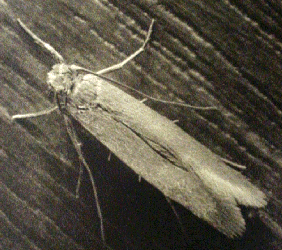
Adult of the Common Clothes Moth (Tineola bisselliella) - colour brownish with golden
or silvery sheen, length 5-8 mm
|
|
Clothes moth damage in Britain has declined in recent years, probably due to the increased
use of man-made fibres, more frequent dry-cleaning, the much drier atmosphere created by central heating, and
the use of insecticides, but the risk of damage to clothing and fabrics still remains fairly high. Householders
should be always vigilant and regularly inspect the contents of wardrobes, cupboards, drawers and other storage
areas, as well as undisturbed areas of carpeting behind and under furniture, for early signs of these moths
before their number build-up and cause serious damage to stored clothing, linen and other household fabrics.
More pictures of Clothes Moths can be found at
UK Moths. |
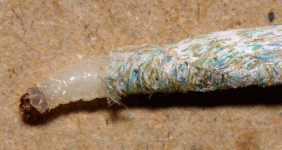
Larva of the Case-bearing Clothes Moth (Tinea pellionella) with its case, up to 10 mm
long
Photo: A. Tiley ©
|
Control of Clothes Moths
The best way to avoid problems with clothes moths is through prevention. Woollens and
other susceptible fabrics should be dry-cleaned or laundered before being stored for long periods. Cleaning
kills any eggs or larvae that may be present and also removes perspiration odours that are attractive to the
pests. Cleaned articles can be sealed in plastic clothes bags to reduce exposure to moths and the chance of
future infestations developing.
Moth infestations are less likely in clothing, carpets and soft furnishings made
from synthetic fibres than in those made from natural materials preferred by moths, such as wool or cotton,
although it is still important to keep synthetic fabrics clean.
Standard household insecticides should not be used to treat clothing. Valuable garments
such as furs can be protected from clothes moths by storing them in refridgerated vaults - a service offered
by some furriers and department stores.
Controlling existing infestations of clothes moths requires patience and a thorough
inspection to locate all potential sources of infestation, including roof spaces and lofts where pipe-lagging,
roof insulation materials or debris from nesting birds may attract and harbour moths. All infested items
should be thrown out, laundered or dry-cleaned.
Vacuum cleaning will effectively remove larvae which are already present as well
as hair, fluff and other debris which could support future infestations. Take care to vacuum infested areas
thoroughly, especially under the edges of carpets, along skirtings and into corners, underneath furniture,
and inside closets, wardrobes, cupboards and other enclosed, dark and undisturbed areas where larvae prefer
to feed or adult moths may hide. Be sure to dispose of the contents of the vacuum cleaner bag after you
clean.
Freeze-treatment can be used for small items such as ornaments and fur toys by
placing them in a home freezer for about a week to kill eggs and larvae, followed by thorough cleaning of
the items.
Insecticide treatment of infested areas is often useful as a supplement to good
housekeeping, but only use products approved and recommended for clothes moth control,
and with a manufacturers guarantee on the packaging that they can be used safely on fabric materials without
staining or damage. Sprays may be applied to carpets, especially along and beneath the edge adjacent to the
skirting, underneath furniture and other likely areas of infestation where prolonged contact with humans or
pet animals is unlikely - clothing and bedding should not be sprayed with insecticides.
N.B. The control measures described above for Clothes Moths are also
applicable to Carpet & Fur Beetles, as well as other domestic
beetle pests that likewise attack carpets, furs and household fabrics.
<<< TOP |
|
Meal, Flour & Wax Moths (Family Pyralidae)
Adult Pyralidae are rather delicate moths with a wingspan of about 20-40 mm, usually more or
less brownish in colour, although the wings of some species are distinctively patterned with contrasting dark
and pale areas, and sometimes with reddish or green-tinged patches. The forewings are generally narrow and the
hind wings somewhat broader, and both pairs of wings bear relatively short fringes. The adult moths, like the
clothes moths, cause no direct damage and it is only the larval stages (or caterpillars) that attack our food
stuffs. |
|
Caterpillars of pyralid moths are generally whitish or pale-yellowish in colour with few
distinguishing features, but often they can be recognise by their vigorous wriggling when disturbed. They feed
on a wide variety of materials, including grain and other stored food products, and many of them live in silken
tubes and tunnels. It is always advisable to keep household foods such as grain, cereals, flour, nuts, etc.,
in well sealed plastic or glass containers - this not only keeps out vagrant moths, but also prevents the spread
of insects which might be introduced accidentally (often as eggs and/or larvae) with newly purchased goods.
|
|
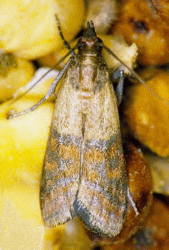
Adult of the
Indian Meal Moth
(Plodia interpunctella)
length 8-10 mm
Photo: J. Kalisch - UNL ©
|
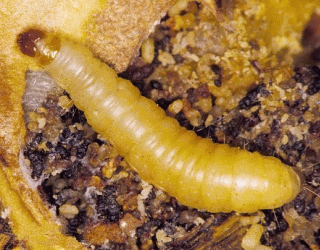
Larva of the Indian Meal Moth
(Plodia interpunctella)
up to 13 mm long
Photo: J. Kalisch - UNL ©
|
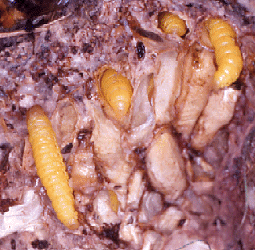
Larvae of the Wax Moth
(Aphomia sociella)
attack the nests of social bees and wasps
and are typical of pyralid caterpillars that
live inside silken tunnels
|
|
The main pest species of stored food include the Flour or Meal Moth
(Pyralis farinalis), the Mediterranean Flour Moth (Ephestia kuehniella) and the
Indian Meal Moth (Plodia interpunctella). The larvae of these and several other species
feed on cereals and cereal products and frequently destroy or damage large quantities of food in granaries
and flour mills. They also attack nuts and dried fruit.
Other pyralid moth pests include the Wax Moth (Galleria mellonella) which
is a pest in honey bee hives, where the larvae feed on the wax of the combs, covering them with silken tunnels.
They may also feed on the offspring of the bees when present in large numbers, and because of this they are much
feared as pests by bee-keepers. The larvae of another common wax moth (Aphomia sociella) attack the nests
of wild social bees and wasps, especially those of bumblebees, where they likewise eat and destroy the brood
comb, as illustrated above (go to the Moth & Butterfly Gallery to see the adult of
this species).
More pictures of Meal, Flour & Wax Moths can be found at
UK Moths. |
Control of Meal & Flour Moths
The best method of avoiding problems with stored product pests is good sanitation.
Be sure that the areas where food is prepared, eaten, and stored are cleaned regularly. Leaving spilled food
or food exposed in open packets and containers attracts and harbours these pests. Avoid such practices and,
together with regular cleaning, you will probably never have a problem. Remember that crumbs and bits of dried
food may accidentally fall behind furniture, under appliances, or into cracks in worktops, storage cupboards
and drawers. Regularly pull out appliances and drawers and thoroughly vacuum these areas to remove all traces
of accumulated debris.
Buy dry food stuffs intend for storage, such as cereals, grain, meal, flour, biscuits,
nuts, dried fruits, etc., only in quantities that you will use in a reasonable length of time. Materials
stored for long periods (e.g., six months or more) are often the source of serious infestations. Pests can
develop here without being noticed. In any event, routinely check all stored food products, especially those
that go extended periods of time between use.
Meal and flour moth caterpillars can chew their way into cardboard boxes and thin
polythene bags. Always keep stored materials in tight-fitting containers, preferably of glass, metal or tough
plastic. If an infestation should occur under these conditions (possibly introduced with newly purchased goods),
it probably will be confined to a single jar or container and easily eradicated by discarding the contents.
Glass jars should have rubber seals, and metal or plastic containers should have tight-fitting lids. Dried pet
foods are one of the most frequent stored products attacked by moth pests, so it is wise to be especially
attentive to the storage of these foods. If you find a container with infested food, place the food container
in a home freezer for about a week, which should kill any livestock that is present. Then discard the infested
material and wash the container thoroughly before reusing.
If a moth infestation becomes apparent, locate the source immediately and get rid of it.
If you act early enough, this may be the only material infested. Examine unopened food packages thoroughly.
If there is the slightest suspicion — be ruthless — throw it out. If the material appears uninfested and you
prefer to keep it, then at least transfer it to a sealed glass, metal or plastic container and inspect it
frequently. Use a vacuum cleaner to remove debris from cracks and corners of infested storage areas. Also
clean all nearby areas, especially spills and crumbs behind and alongside appliances. Scrub the storage space
and vicinity with very hot water and a good household kitchen cleaner or strong detergent solution. Allow to
dry thoroughly before replacing food stuffs.
Insecticide control of household food pests is not generally recommended and can only
supplement the more important steps of sanitation. Only use insecticides well away from areas where food is
stored, prepared or eaten and then only as a last resort - for example, to treat inaccessible cracks and
crevices in other parts of the house or building (away from food) where caterpillars or adult moths may have
crawled or flown away from an infested food source and hidden themselves.
N.B. The control measures described above for Meal and Flour Moths are also
applicable to Grain & Flour Beetles, as well as other domestic beetle
pests that likewise attack dried food products.
<<< TOP |
|
|
MORE ON MOTHS
Order Lepidoptera
<<< HERE >>> |
|
|
<<< TOP |
(use the back button on your web browser to return to the previous page) |
TOP >>> |
|






